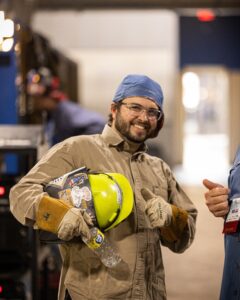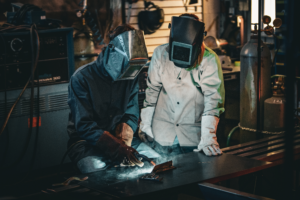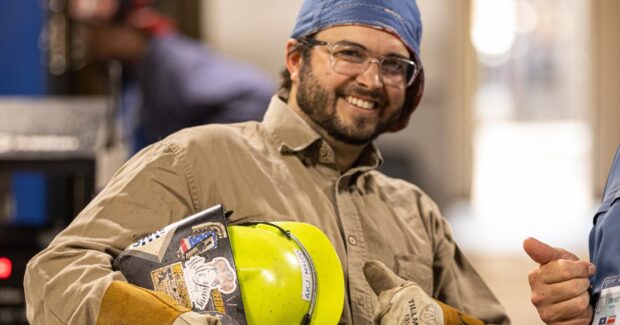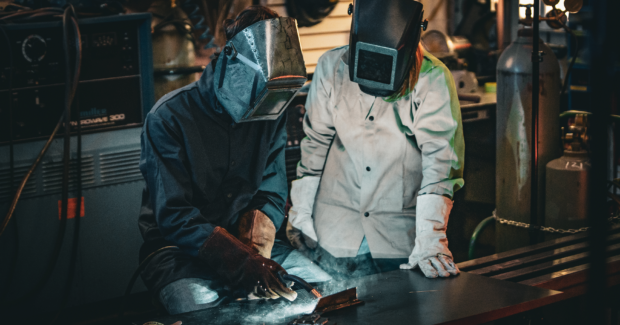Apprenticeship Programs Key to the Future of Welding
Fabricators who want to address the welder shortage may feel like they face these challenges alone, but there is help.
Posted: October 1, 2024

When it comes to creating a winning sports team, some organizations invest heavily in star players through expensive free agency deals (think New York Yankees). Other teams take a “draft and develop” approach. Their scouts find players with raw potential, then they develop the players through good coaches and strong training system (think Super Bowl-winning Kansas City Chiefs).
Metal fabrication companies can also take a similar approach to boosting their in-house welding talent. While they may need to acquire the occasional superstar with advanced certifications or experience welding exotic alloys, many fabricators realize that their best bet for finding good talent is to grow it in-house.
“In the long run, building and training your own workforce improves retention and lowers cost,” said Monica Pfarr, executive director of the AWS Foundation. “With this approach, you can find people with the best fit for your company culture, then grow their skills.”
Critical Need

Virtually every fabricator is competing for welding talent. The American Welding Society’s (AWS) website notes that there are currently an estimated 771,000 welding professionals in the U.S. More than 159,000 of those professionals are approaching retirement, only 9.4% of them are younger than 25, and we need to fulfill 82,500 new welding jobs per year between 2024 and 2028.
“Leaders in industry and in Washington, D.C. note that the need for welders and other skilled trades is critical,” Pfarr said. “We need them to strengthen our manufacturing industries, to help reshore work and to build the ships, planes, tanks, electronics and other components essential for the U.S. defense industrial base.”
The need for welders in the defense industry is so critical that the U.S. Navy has launched a program called Build Submarines that promotes career paths for welding. A group called BlueForge Alliance is the non-profit integrator for the U.S. Navy’s Submarine Industrial Base Program. They have recently agreed to sponsor the AWS Foundation’s Careers in Welding Mobile Experience for two years, along with Lincoln Electric. Other skilled trade careers being showcased through BlueForge Alliance include Major League Baseball and NASCAR.
In a press release statement, Brad Keselowski, co-owner and driver, RFK Racing, said “I’m proud to support a cause of such vital significance to our country with this new partnership. We hope to inspire the workforce of the next generation across the country when they see RFK race and hear our message.”
A Ready-to-Use Template
Fabricators who want to address the welder shortage may feel like they face these challenges alone, but there is help. To connect employers, institutions and aspiring welders, the AWS Foundation helped develop a welding occupation Registered Apprenticeship Program. The AWS Foundation is the philanthropic arm of AWS. Its mission is to ensure the growth of the industry through career programs, scholarships and grants to institutions that offer welding education and training.
The AWS Foundation worked with two other organizations to create the apprenticeship program: Safal Partners, to whom the U.S. Department of Labor granted the right to lead its Registered Apprenticeship Technical Assistance Center of Excellence, and Fastport, which is also a U.S. DOL intermediary that support employers with registered apprenticeships.
“By creating National Guidelines for Apprenticeship Standards, AWS did the heavy lifting so that companies have a template for implementing a high-quality Registered Apprenticeship welding program,” Pfarr said. “Employers can take workforce training into their own hands. By using our template, they can be confident that their program will fully satisfy regulatory requirements at the federal and state level. Further, Registered Apprenticeships are suitable for union and non-union shops and companies of all sizes.”

With a Registered Apprenticeship Program, an employer partners with an educational institution to provide an apprentice on-the-job training, mentorship, and classroom-based instruction. The apprentice is considered a paid employee and is expected to produce high-quality work that contributes to the company’s success while completing their training. An apprenticeship requires three-to-five years to complete and requires about 8,000 hours of training. More than 90% of the hours are spent in on-the-job training while the remaining hours are instructional training, often provided by a technical college.
“AWS provides the appropriate structure for a welding-oriented program, and we package in some of our education and training components that are proven to meet the needs of industry,” Pfarr said.
Registered Apprenticeships provide employers with benefits because they may be able to offset labor costs through state tax credits and federal funding, including the GI Bill and veterans programs, federal student aid funds and the Workforce Innovation and Opportunity Act.
Card to Success
Upon completion of an apprenticeship program, aspiring welders receive industry-recognized credentials including AWS Certified Welder, a Journeyman’s card and other industry relevant safety certifications, such as OSHA, MSHA, etc. The industry calls these “portable” credentials because they are recognized in any state. However, welders-in-training also need to know that most companies will require prospects to pass their own welding test. That said, going through the rigors of an apprenticeship program and becoming a certified welder is the best possible preparation for a welding test.



















